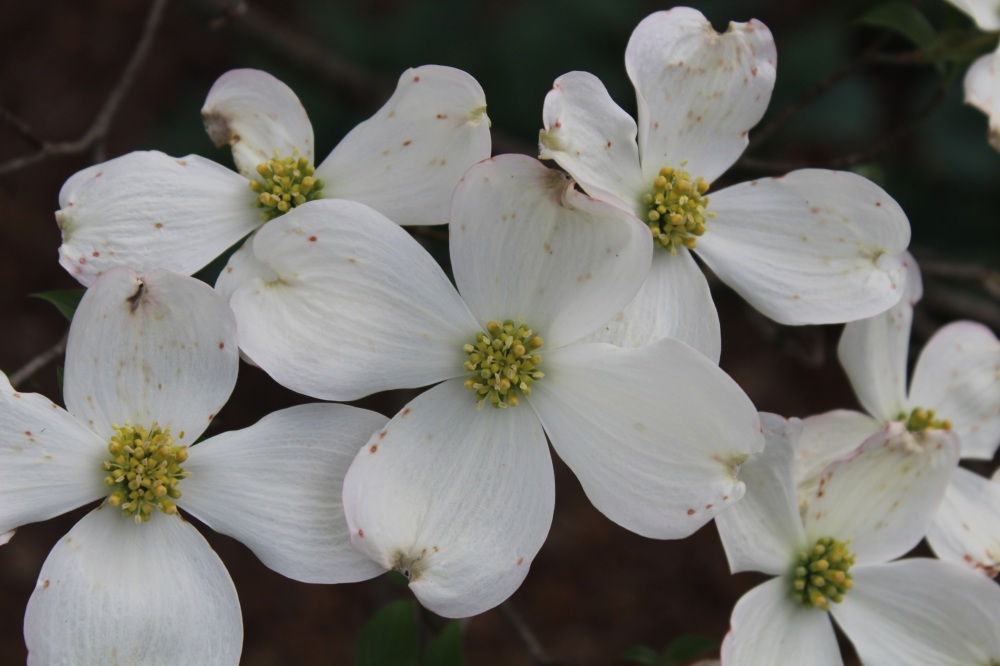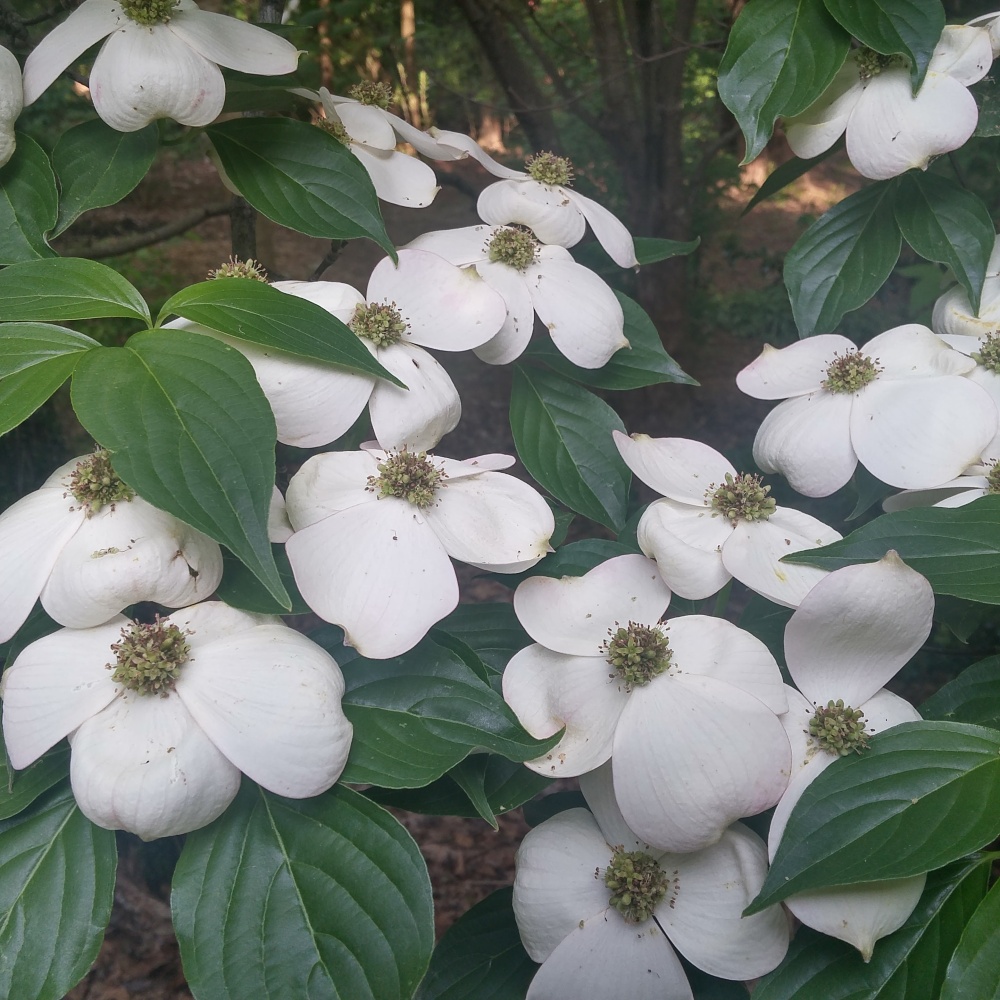For better or worse, this is a garden oriented around trees, and of collections of too many plants that have captured my favor. There are nearly forty Japanese maples, with a few small ones in containers placed on patios, but most nearly mature trees that have been planted over three decades. There are a dozen or more dogwoods, and there would be more maples and dogwoods if space allowed. My wife complains that when she looks out the windows she can’t see the sky, and somewhere out there is a lovely view of the Blue Ridge mountains, but I’m happy to see dogwood blooms instead.
 In late May, we are nearing the end of a progression of dogwoods flowering that began with the Cornelian cherry (really a dogwood, Cornus mas ‘Variegata’, above) in early March. After a two week gap, the native dogwoods (Cornus florida, below) flowered in early April, followed by several hybrids, and now there are a few weeks before flowers of late blooming Chinese dogwoods (Cornus kousa) fade completely in mid June (or later). By planting as few as three well chosen dogwoods there can easily be flowers for two months, and there are few trees to compare in beauty.
In late May, we are nearing the end of a progression of dogwoods flowering that began with the Cornelian cherry (really a dogwood, Cornus mas ‘Variegata’, above) in early March. After a two week gap, the native dogwoods (Cornus florida, below) flowered in early April, followed by several hybrids, and now there are a few weeks before flowers of late blooming Chinese dogwoods (Cornus kousa) fade completely in mid June (or later). By planting as few as three well chosen dogwoods there can easily be flowers for two months, and there are few trees to compare in beauty.
The Cornelian dogwood is unremarkable, except that it flowers in late winter, which could be late February or mid March depending on late winter temperatures. While some late winter flowers are damaged by cold, the dogwood’s have not been injured by temperatures in the teens, and lower. With wide white margins, the variegated leaf version of Cornus mas appears almost white from a distance.
There are several versions of the native American dogwood in the garden that begin flowering in early to mid April, with several seedlings growing at the forest’s edge, and ‘Cherokee Princess’, a vigorous selection of the white flowered dogwood. Another white dogwood might be ‘Princess’ or not, since long ago it was incorrectly tagged as pink, but flowered white. A white dogwood with pendulous branching (Cornus florida ‘Pendula’) hardly makes a show, and if there is a single tree in the garden that could be done without, this is clearly the one. There are many better choices.
I hesitate to recommend against the red flowered, variegated dogwood ‘Cherokee Sunset’ (above), though it has not flowered in the past decade. I suspect it is in damper ground than it would prefer, and though it survives, it barely grows. This, I attribute to a failing on my part, though in the best circumstance it is less vigorous than other dogwoods. Still, its foliage is lovely, and when I’ve seen ‘Sunset’ flowering it is well worth planting.
While the native dogwood is prone to a variety of mildews, cankers, and foliage diseases, ones in this garden have survived with only minor issues for twenty years and longer. Powdery mildew and leaf spotting are regular occurrences in the heat of summer, but other dogwoods cannot match the autumn foliage color and clusters of red berries of the native.
 Just as the native dogwood begins to fade, hybrid dogwoods come into flower. ‘Celestial Shadow’ (above, top) and ‘Stellar Pink’ (above) are hybrids that combine the best traits of our native and Chinese dogwoods. Flowers arrive at about the same time that leaves begin to emerge, so flowers have a green backdrop, or in the case of the variegated ‘Celestial Shadow’, a background of green and yellow. ‘Venus’ (below) is a hybrid of the Chinese and Pacific dogwood (Cornus nutallii) that has a similar upright habit to ‘Celestial Shadow’ and Stellar Pink’, but is distinguished by unusually large white flowers.
Just as the native dogwood begins to fade, hybrid dogwoods come into flower. ‘Celestial Shadow’ (above, top) and ‘Stellar Pink’ (above) are hybrids that combine the best traits of our native and Chinese dogwoods. Flowers arrive at about the same time that leaves begin to emerge, so flowers have a green backdrop, or in the case of the variegated ‘Celestial Shadow’, a background of green and yellow. ‘Venus’ (below) is a hybrid of the Chinese and Pacific dogwood (Cornus nutallii) that has a similar upright habit to ‘Celestial Shadow’ and Stellar Pink’, but is distinguished by unusually large white flowers.
More than just filling the time period after the native dogwood stops blooming (late April), the hybrids are the most vigorous of dogwoods, and most disease resistant, though Chinese dogwoods (Cornus kousa) are also very tough. As always, I caution that ‘Stellar Pink’ is rarely pink in my Virginia garden. One in ten years, flowers will be more than a slight blush of pink, but it flowers heavily and this slight failing is no reason for it to be avoided. 
The end of the dogwood flowering season is filled by Chinese dogwoods that overlap with the blooms of the hybrids in mid to late May, with flowers often persisting for several weeks into June in the garden. There are several green leafed Kousas in the garden, with white flowers (‘Galilean’, above) and the blush pink ‘Satomi’ (below) that is slightly more dependable for color than ‘Stellar Pink’. Chinese dogwoods take a variety of forms from tall and upright to spreading habits.
The variegated ‘Wolf Eyes’ (below) is more shrub than tree, and after fifteen years it is barely taller than eight feet, though it is half again as wide. The leaves of ‘Wolf Eyes’ are curled, so variegation is not displayed as prominently as on ‘Samaritan’ (below, bottom), which is also much more upright and vigorous, though it is planted so that its lower branches are shaded so it flowers only on its upper third.
